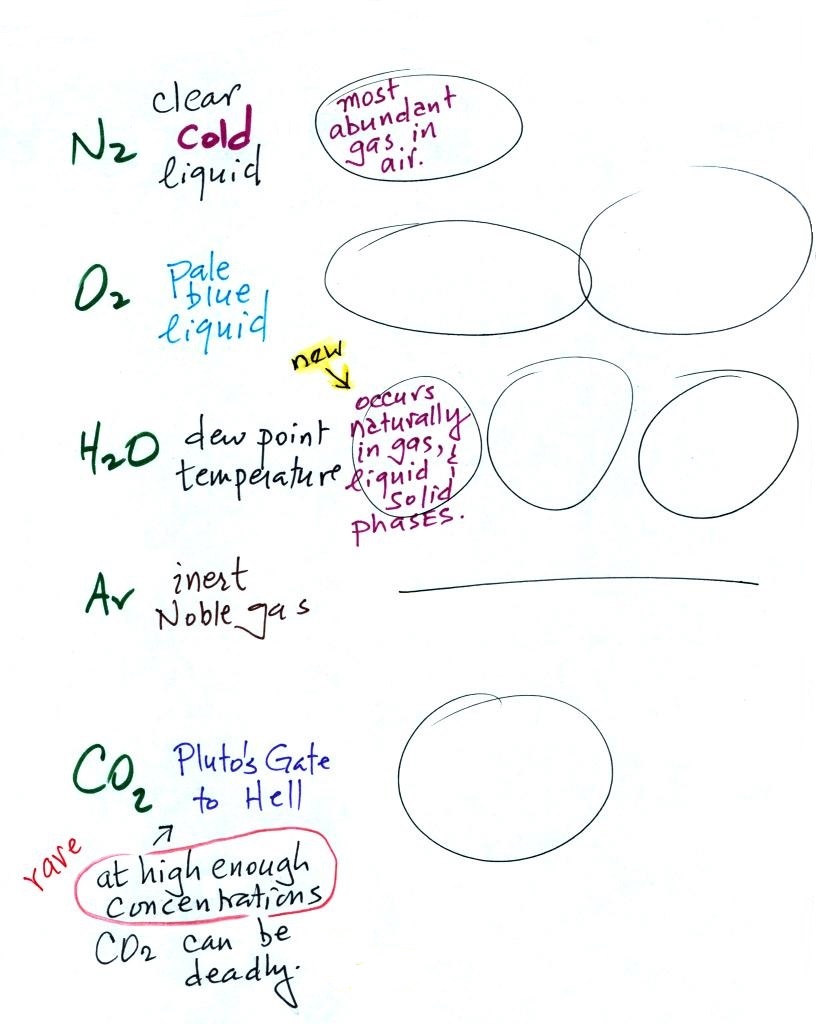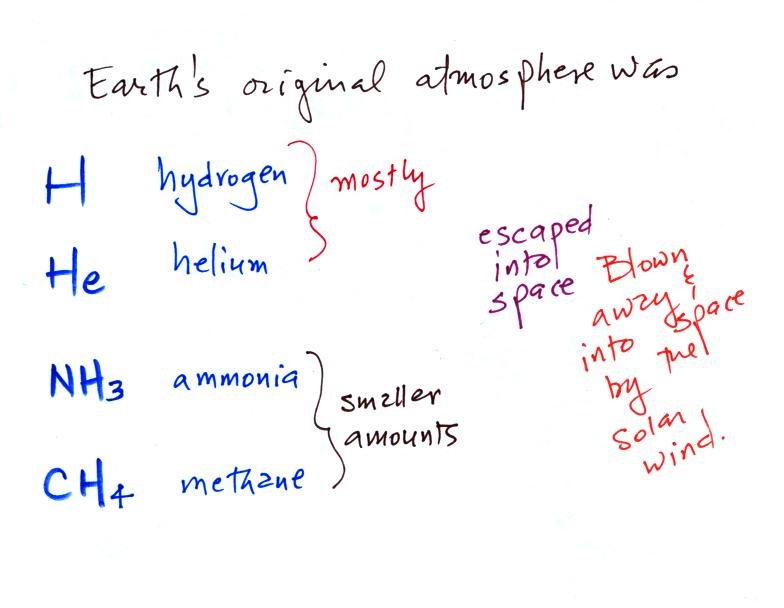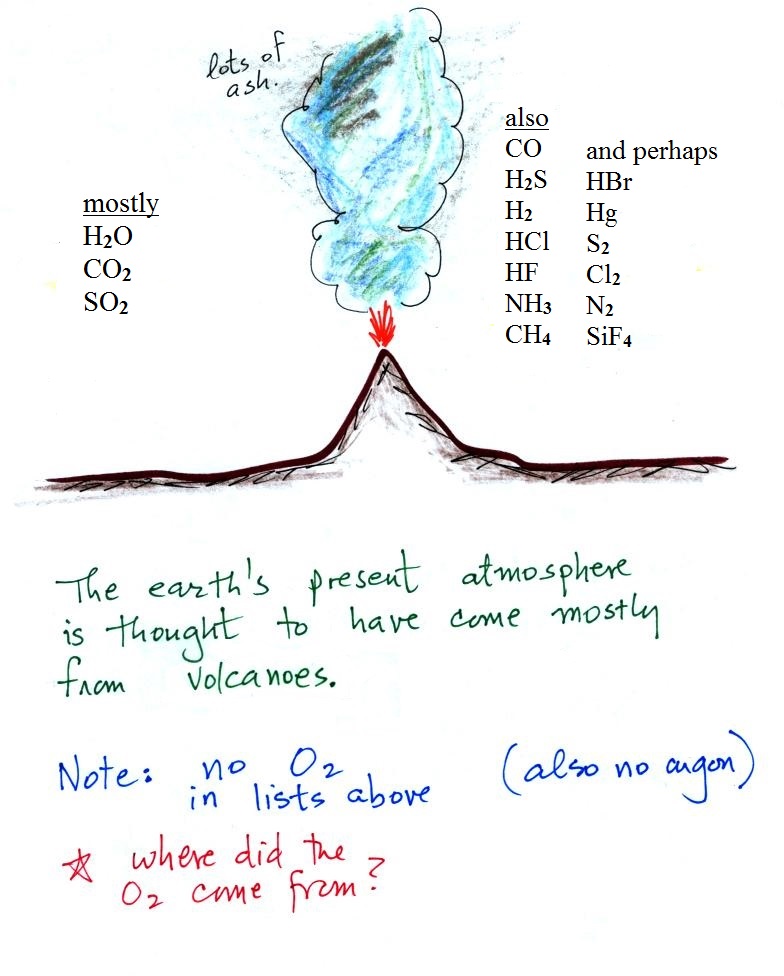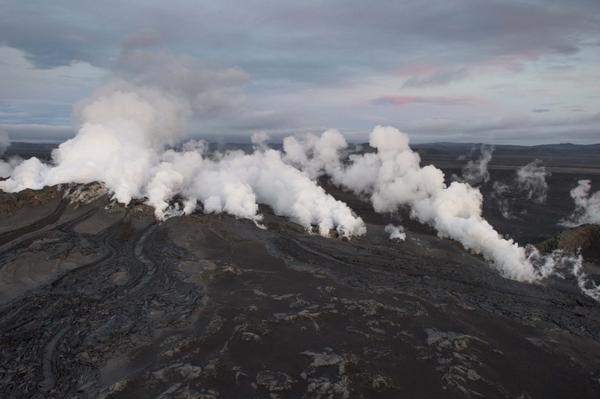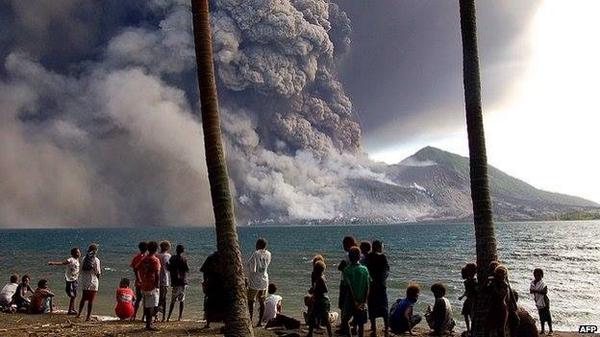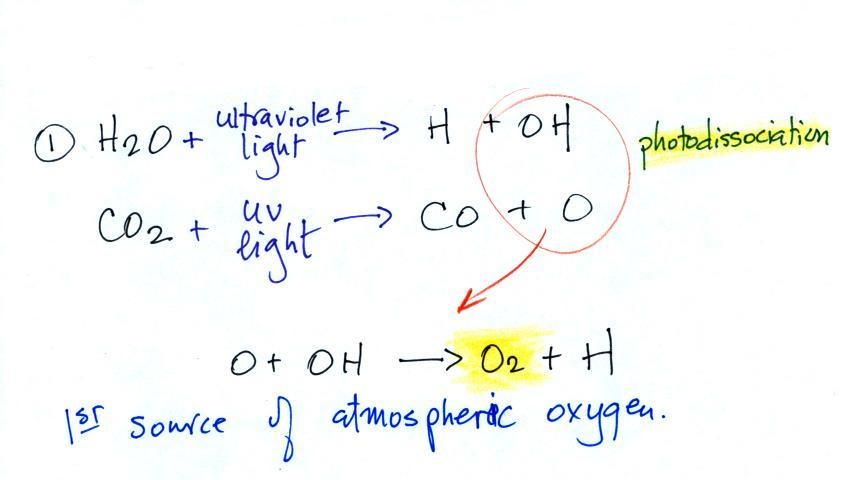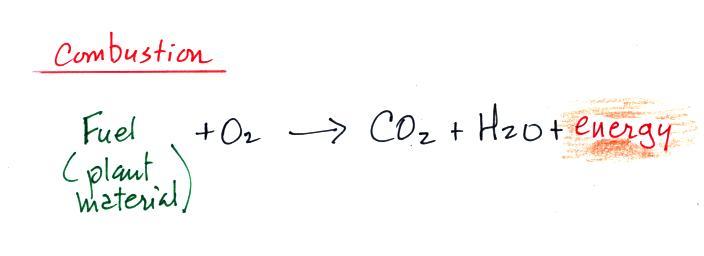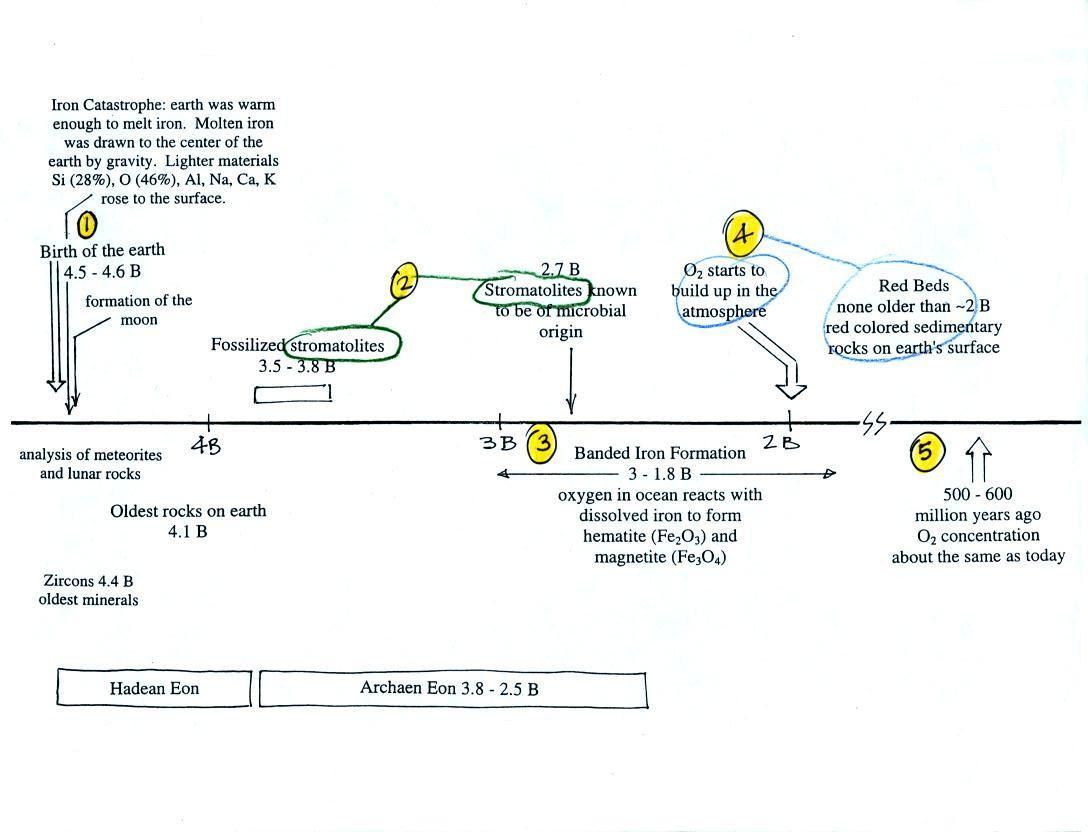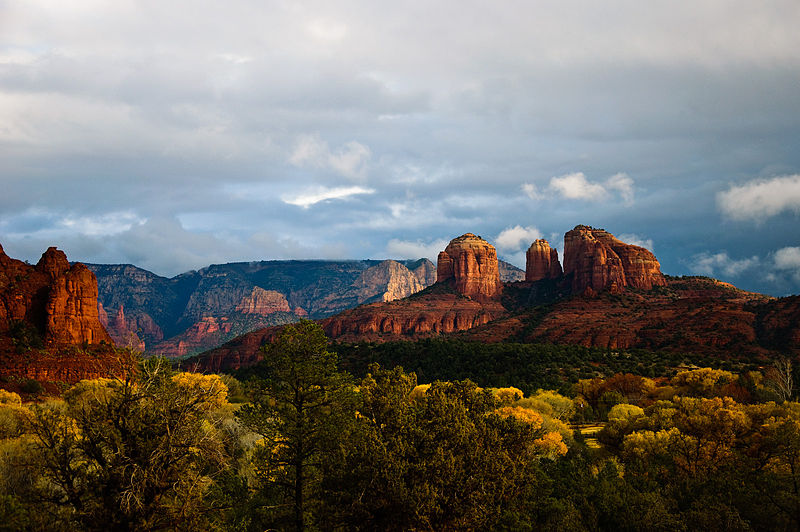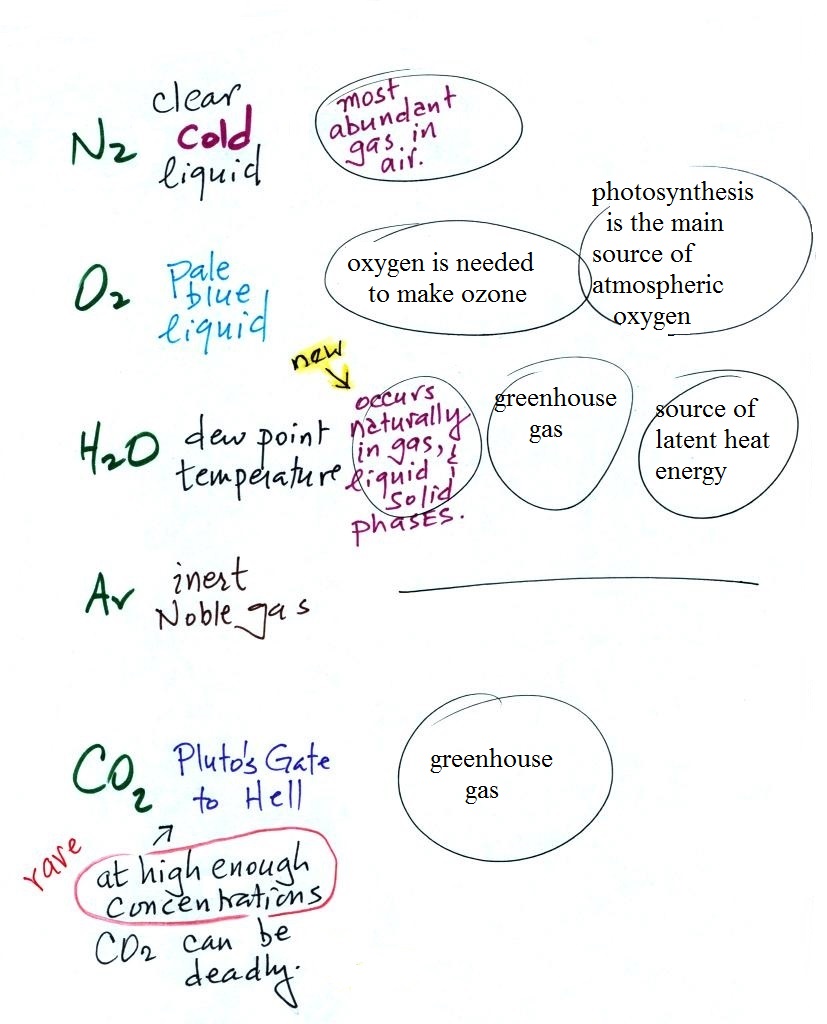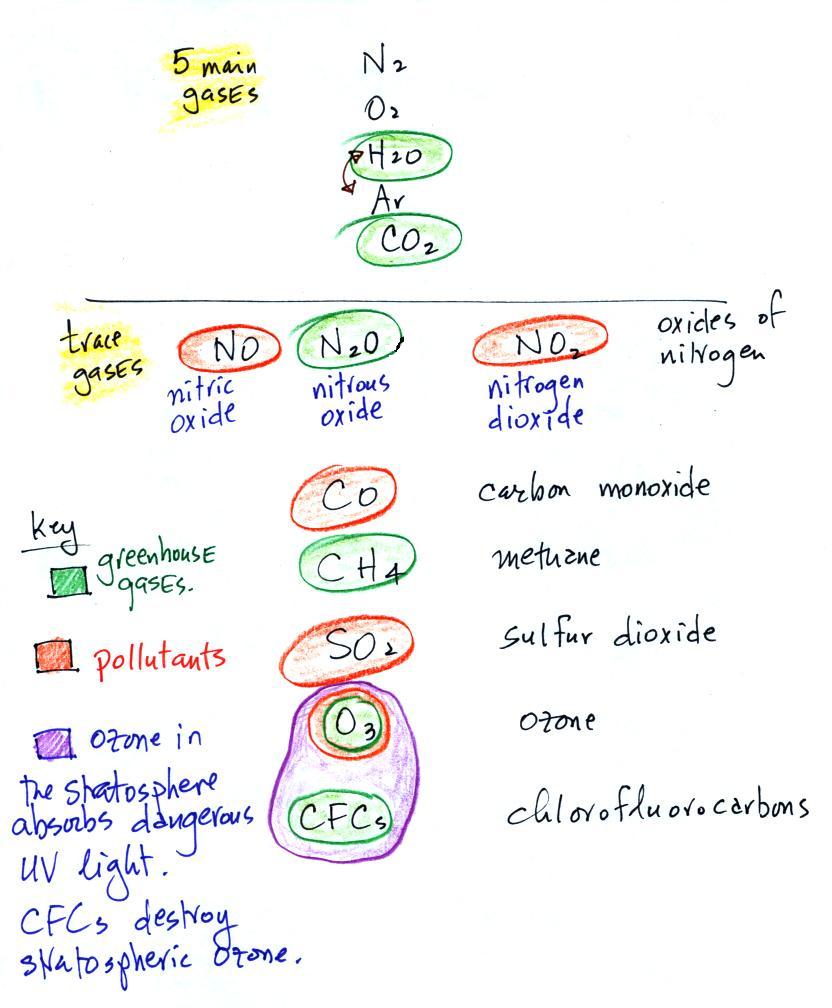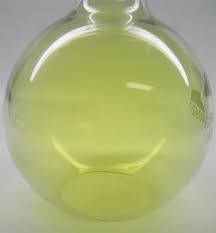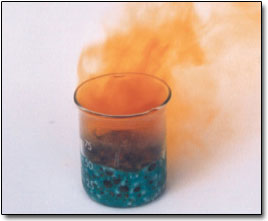Thursday Aug. 28, 2014
A nice selection of music from Sergio Mendoza
y La Orkesta recorded in Austin, TX, this past summer during
the SXSW festival. They're a local group and will be playing
downtown this coming Sunday night, I believe, as part of the HOCO
Fest.
Experiment #1 materials checkout
About 45 sets
of Experiment #1 materials were checked out before class
today. Those of you that have materials will eventually find
your name on the Expt. #1 signup list.
Even though your report isn't due until Sep. 23, the experiment
can take several days, maybe even a week, to run to completion so
don't wait too long to get it started; this weekend would be a
perfect time. You may need to check the experiment fairly
frequently at the beginning (every hour or two). It slows
down somewhat as it progresses and eventually you will only need
to look at it once or twice a day. You'll find more
information about the experiment here.
Once you have collected your data, return your
materials and pick up the supplementary information handout.
Try to do this before the experiment report is due because the
handout will help with the analysis portion of your report.
It will also make materials available for someone else that wants
to do the experiment. Your name should turn this rust color
on the signup list when you have returned your
materials.
Signup sheets for the remaining
experiments were circulated in class. If you didn't get a
chance to signup don't worry, I'll bring the lists to class again
next week. And remember you only need to do one of the
experiments. You can check on the appropriate list to see if
your name is there (it will take a few days to enter all the
names)
Storm photographs
Close to an inch of rain fell on campus
during Tuesday afternoon's storm. The Arizona
Daily Star has some pretty good photographs of flooded
streets.
And speaking of photography you really should spend a few
minutes looking at some of Mike Olbinski's Storm
Photography. He really has some amazing
pictures.
Here's the list of the 5 most abundant gases in our
atmosphere again together with what we learned about them in
class on Tuesday.
We'll be learning more about some of these gases today and
will be filling in the open circles with new information.
The earth's original atmosphere and the origin(s) of
our present atmosphere
Our present day atmosphere is very different from the earth's
original atmosphere which was mostly hydrogen and helium with
lesser amounts of ammonia and methane.
I'm not sure I mentioned how/why the
earth lost its first atmosphere. It
probably either escaped (the earth was hot and light weight
gases like hydrogen and helium were moving around with enough
speed that they could overcome the pull of the earth's gravity)
and was swept into space by the solar wind
(click on the link if you are interested in learning more about
the solar wind, otherwise don't worry about it).
With the important exception of oxygen (and
argon), most of our present atmosphere is though to have come
from volcanic eruptions. In addition to ash, volcanic
eruptions send a lot of water vapor, carbon dioxide, and sulfur
dioxide into the atmosphere. Carbon dioxide
and water vapor are two of the main gases in our present
atmosphere.
Volcanoes also emit lots of other gases,
many of them are poisonous. Some of them are shown on
the right side of the figure (I found the gases in the "also"
list mentioned in a lot of online sources, the gases in the
"perhaps" list were mentioned less frequently).
As the earth began to cool the water vapor condensed and
began to create and fill oceans. Carbon dioxide
dissolved in the oceans and was slowly turned into rock.
Smaller amounts of nitrogen ( N2 ) are also emitted by
volcanoes.. Because nitrogen is relatively nonreactive
it remained in the air and its concentration was able to built
up over time.
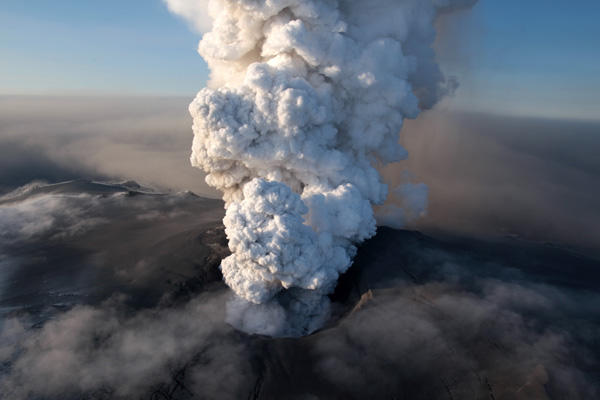
The photo above shows the
Eyjafjallajokull volcano in Iceland photographed on Apr. 17,
2010 (image
source)
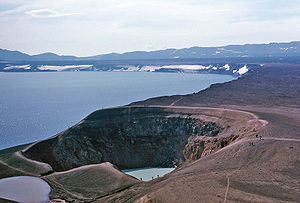
|
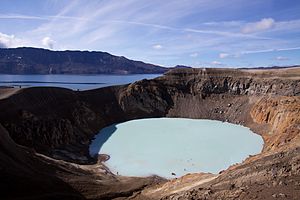
|
Water has filled the Askja volcano caldera
forming Oskjuvatn Lake. The lake covers 12 sq.
kilometers and is 220 m deep. The small lake in the
foreground is Viti lake.
|
Closeup of Viti geothermal lake.
Source of both
images
|
There has been an increase in earthquake
activity around the Bardarbunga volcano in Iceland
(which lies underneath a glacier) and there is concern
that magma might move from Bardarbunga into the nearby
Askja volcano (shown above) and cause it to erupt
(see this
Aug. 27 reference for more information).
Friday Aug 29 update
We didn't have to wait very long to hear about activity
coming from Iceland. A small fissure eruption was
observed overnight at the Bardarbunga volcano.
Midnight fissure eruption at the
Bardarbunga volcano in Iceland (source
of this image)
A much bigger eruption at the
Tavurvur volcano on New Britain Island in Papua New Guinea
also occurred overnight sending ash and dust up to 60,000
feet.
The Tavurvur eruption (
source
of this photograph)
Tavurvur is
a pretty active volcano. The town of Rabaul is located
nearby. I spend some time there as part of a field
experiment in 1992. The same volcano erupted in 1994 and
buried Rabaul.
Where did the oxygen in our atmosphere come from?
Volcanoes didn't add any of the oxygen that is in the
atmosphere. Where did that come from? There are a
couple of answers to that question.
1st source of atmospheric oxygen
The oxygen is thought to have come from
photo-dissociation of water vapor and carbon dioxide by
ultraviolet (UV) light (the high energy UV light is able to split
the H20 and CO2 molecules into pieces). The O and OH then
react to form O2 and H.
By the way I don't expect you to remember the chemical formulas
in the example above. It's often easier and clearer to show
what is happening in a chemical formula than to write it out in
words. If I were to write the equations down, however, you
should be able to interpret them. Ultraviolet is a
dangerous, high energy, potentially deadly form of light and it's
probably also good to remember that ultraviolet light is capable
of breaking molecules apart.
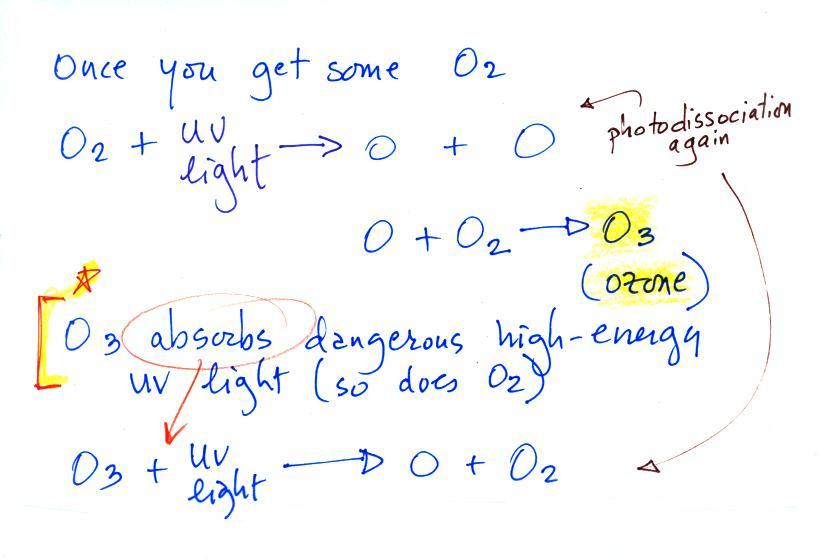
Once molecular oxygen (O2) begins to accumulate in
the air UV light can split it apart to make atomic oxygen
(O). The atoms of oxygen can react with molecular oxygen
to form ozone (O3).
Ozone in the atmosphere began to absorb the dangerous and
deadly forms ultraviolet light and life forms could then begin
to safely move from the oceans onto land (prior to the buildup
of ozone, the ocean water offered protection from UV
light. A molecule of O3 absorbs some UV
preventing it from reaching the ground.
O3 + UV light ---> O2 + O
You might think the O2
and O would recombine, but they usually go flying off in
different directions. This ozone
destruction reaction wasn't shown in class.
2nd and most important source of atmospheric
oxygen.
Photosynthesis is now the main source of atmospheric
oxygen.
Photosynthesis in its most basic form is shown in the chemical
equation above. Plants need water, carbon dioxide, and
sunlight in order to grow. They can turn can turn H20 and CO2 into plant material. Photosynthesis
releases oxygen as a by product.
Combustion is really just the opposite of photosynthesis and is
shown below.
We burn fossil fuels (dead but undecayed plant material) to
generate energy. Water vapor and carbon dioxide are by
products. Combustion is a source of CO2. We'll
see these two equations again when we study the greenhouse effect
(CO2 is
a greenhouse gas ) and global warming.
And a detail that I didn't mentioned
in class (and something you probably don't need to
remember). The argon we have in the atmosphere apparently
comes from the radioactive decay of potassium in the ground.
Three isotopes of potassium occur naturally: potassium-39 and
potassium-41 are stable, potassium-40 is radioactive and is the
source of the argon in the atmosphere.
Stromatolites, banded iron, red beds - geological
evidence of oxygen on earth
The following figure is the first page in the packet of
photocopied ClassNotes.
This somewhat confusing figure shows some of the important
events in the history of the earth and evolution of the
atmosphere. There were 5 main points I wanted you to take
from this figure, and really 1-3 are the most important.
First, Point 1: the
earth is thought to be between 4.5 and 4.6 billion years
old. If you want to remember the earth is a few billion
years old that is probably close enough. Something I
didn't mention in class, it's in small type above.
The formation of a molten iron core was important because it gave
the earth a magnetic field. The magnetic field deflects the
solar wind and keeps the solar wind from blowing away our present
day atmosphere.
Stromatolites (Point
2) are column-shaped
structures made up of layers of sedimentary rock,
that are created by microorganisms living at the top of the
stromatolite (I've never actually seen a stromatolite, so this
is all based on photographs and written descriptions).
Fossils of the very small microbes (cyanobacteria = blue green
algae) have been found in stromatolites as old as 2.7 B years
and are some of the earliest records of life on earth.
Much older (3.5 to 3.8 B years old) stromatolites presumably
also produced by microbes, but without microbe fossils, have
also been found.
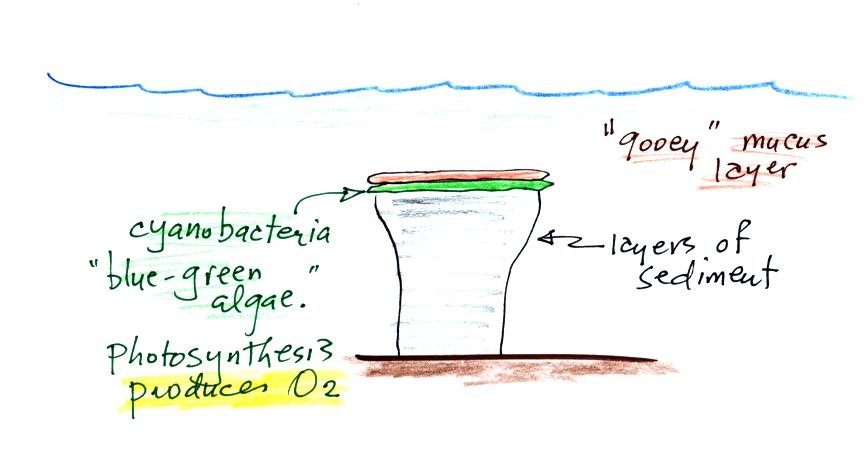
Blue green algae grows at the top of the column, under water
but near the ocean surface where it can absorb sunlight. As
sediments begin to settle and accumulate on top of the algae they
start to block the sunlight. The cyanobacteria would then
move to the top of this sediment layer and the process would
repeat itself. In this way the stromatolite column would
grow layer by layer over time. Now, this isn't a geology
class; we're learning about stromatolites because the
cyanobacteria on them were a very early form of life on the earth
and were able to produce oxygen using photosynthesis.
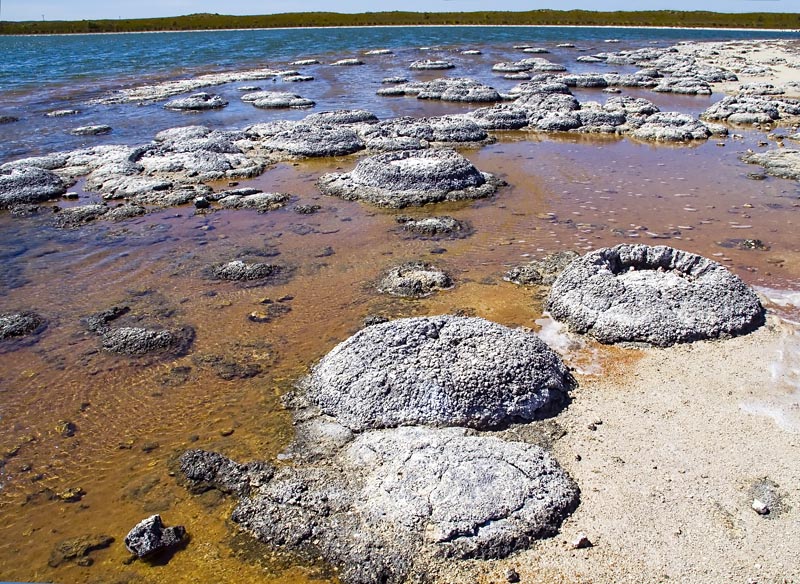
|
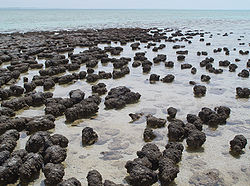
|
Living stromatolites are found in
a few locations today.The two pictures above are from Lake
Thetis (left) and Shark
Bay (right) in Western Australia (the two
photos above and the photograph below come from this source).
The picture was probably taken at low tide, the stromatolites
would normally be covered with ocean water. It doesn't look
like a good place to go swimming, I would expect the top surfaces
of these stromatolites to be slimy.
Living stromatolites at Highborne Cay in the Bahamas.
Point 3
refers to the banded iron formation, a type of rock
formation. These rocks are 3 billion years old (maybe older)
and are evidence of oxygen being produced in the earth's
oceans. Here are a couple of pictures of samples of banded
iron formation rock that I passed around in class (thanks for
being careful with them and not stealing them). Thanks also
for being careful with the glass graduated cylinders. I
don't believe any were broken in either of the sections.
The main thing to notice are the alternating bands
of red and black. The next paragraph and figure explain
how these formed.
Rain would first of all wash iron ions from the earth's land
surface into the ocean (at a time before there was any oxygen
in the atmosphere). Oxygen from the cyanobacteria living
in the ocean water reacted with the dissolved iron (the iron
ions) to form hematite or magnetite. These two minerals
precipitated out of the water to form a layer on the sea
bed. This is what produced the black layers.

Periodically the oxygen production would
decrease or stop (rising oxygen levels might have killed the
cyanobacteria or seasonal changes in incoming sunlight might
have slowed the photosynthesis). During these times of low
oxygen concentration, red layers of jasper would form on the
ocean bottom. The jasper doesn't contain as much
iron.
Eventually the cyanobacteria would recover, begin producing
oxygen again, and a new layer of hematite or magnetite would
form. The rocks that resulted, containing alternating
layers of black hematite or magnetite and red layers of jasper
are known as the banded iron formation.
In addition to the red and black layers, you see yellow layers
made of fibers of quartz in the samples passed around
class. The rocks are fairly heavy because they
contain a lot of iron, but the most impressive thing about them
in my opinion is their age - they are a few billion years
old!
Eventually the oxygen in the oceans reacted with and used up
all of the iron ions. Oxygen was then free to move from the ocean
into the atmosphere. Once in the air, the oxygen could react
with iron in sediments on the earth's surface. This produced
red colored (rust colored) sedimentary rock. These are
called "Red Beds" (Point 4).
None of these so-called red beds are older than about 2 B years
old. Thus it appears that a real buildup up of oxygen in the
atmosphere began around 2 B years ago.
Red State Park near Sedona Arizona. An example of
"red beds" that formed during the Permian period
250-300 million years ago.
Oxygen concentrations reached levels that are about the same as
today around 500 to 600 million years ago (Point 5 in the figure).
Here's our earlier list with some
additional details added
We had time to add to the list also.
Trace gases in air - pollutants and greenhouse
gases
Carbon monoxide, nitric oxide, nitrogen dioxide, ozone, and
sulfur dioxide are some of the major air pollutants.
We'll cover 3 of these in more detail next week.
Water vapor, carbon dioxide, methane, nitrous oxide (N2O = laughing gas),
chlorofluorocarbons, and ozone are all greenhouse gases.
Increasing atmospheric concentrations of these gases are
responsible for the current concern over climate change and
global warming. We'll discuss this topic and learn more
about how the greenhouse effect actually works later in the
course.
Ozone has sort of a Dr. Jeckyl and Mr. Hyde personality
(i)
Ozone in the stratosphere (a layer of the atmosphere between
about 10 and 50 km altitude) is beneficial because it
absorbs dangerous high energy ultraviolet (UV) light coming
from the sun. Without the protection of the ozone
layer, life as we know it would not exist on the surface of
the earth. It was only after ozone started to buildup
in the atmosphere that life could move from the oceans onto
land. Chlorofluorocarbons are of concern in the
atmosphere because they destroy stratospheric ozone.
(ii)
In the troposphere (the bottom 10 kilometers or so of the
atmosphere and where we live) ozone is a pollutant and is
one of the main ingredients in photochemical smog.
(iii) Ozone is also
a greenhouse gas.
Finally, I wasn't
being entirely honest when I said that gases are
invisible. Some gases can be seen, here are some
examples. I would like to bring some actual
samples to class, but some are very toxic and require
careful handling.
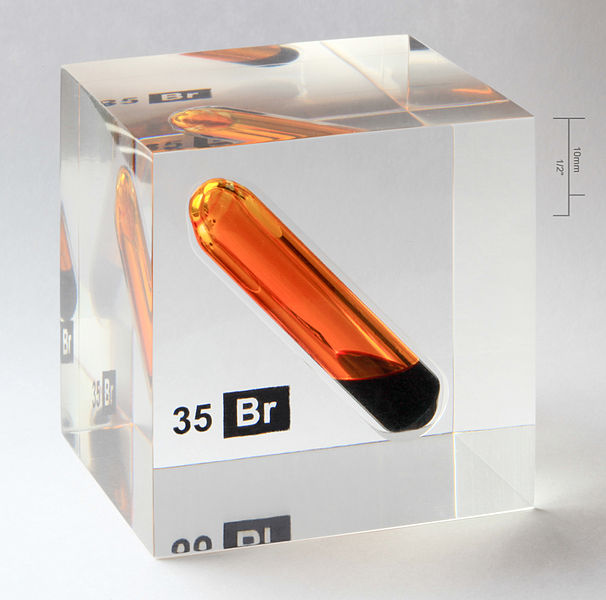 |
|
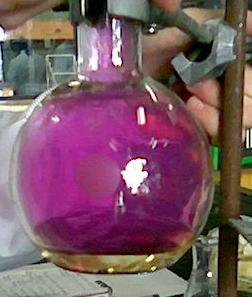 |
|
Bromine in
both liquid and gaseous phases. Bromine and
mercury are the only two elements that exist as
liquids at room temperature. The bromine is
in a sealed glass ampoule inside an acrylic
cube. Bromine could be safely brought to
class in a container like this.
This photo was taken by Alchemist-hp and was
Picture of the Day on the English Wikipedia on Oct.
29, 2010.
|
Chlorine (Cl2)
I found this image here
|
Iodine
Also an element that is normally found in solid
form. The solid sublimates, i.e. it changes
directly from solid to gas (you would probably
need to heat the solid iodine to produce gas as
dense as seen in the picture above). source
of this image
|
Nitrogen dioxide (NO2)
An important pollutant.
source
of this image
|
